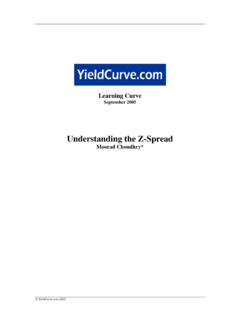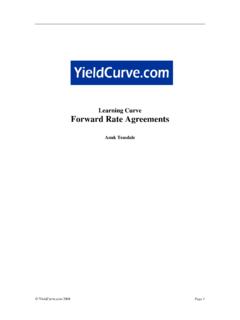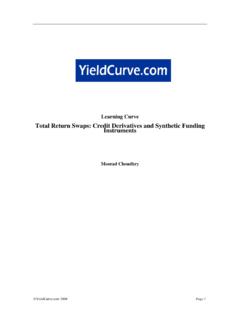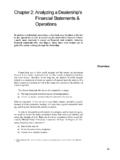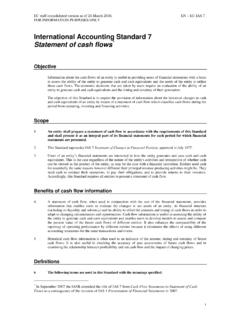Transcription of Financial market liquidity and the Repo instrument
1 1. Financial market liquidity and the Repo instrument Moorad Choudhry September 2006. 2006. 2. The repo market is a vital element of the global capital and money markets. The first repo transactions were initiated by the US Federal Reserve in 1918, since which time repo has become the main instrument of open market operations for virtually all central banks around the world. It is also a major component of the global money markets. The market experienced substantial growth during the 1990s and is now estimated to account for up to 50% of daily settlement activity in non US. government bonds world-wide; this is a phenomenal figure. Daily outstanding volume in international repo transactions has been estimated at between 440 to 450 billion.
2 Repo, from sale and repurchase agreement , is closely linked to other segments of the debt and equity markets. From its use as a financing instrument for market makers to its use in the open market operations of central banks, and its place between the bond markets and the money markets, it integrates the various disparate elements of the marketplace and allows the raising of corporate finance across all sectors. Repo is an interesting product because although it is a money market product, by dint of the term to maturity of repo trades, the nature of the underlying collateral means that repo dealers must be keenly aware of the bonds that they trade as well. This multi-faceted nature of repo is apparent in the way that banks organise their repo trading.
3 In some banks it is part of the money market or Treasury division, while in other banks it will be within the bond trading area. Equity repo is sometimes a back office activity, as is the longer-established stock borrowing desk. However it is not only commercial and investment banks that engage in repo transactions. Across the world, including Financial centres in the Asia-Pacific region, repo is a well- established investment product, utilised by fund managers, hedge funds, corporate treasuries and local authorities. The practicality and simplicity of repo means that it can be taken up even in capital markets that are still at an emerging stage, and by a wide range of participants. It is traded in virtually every country with a debt capital market .
4 The use of repo enhances the liquidity of bond and equity markets, which reduces costs for issuers of capital, and allows market makers to hedge with greater efficiency. Given its size and importance, it is surprising that repo has such a low profile, for example there is little discussion of it in the Financial press. This reflects the simple and straightforward nature of the instrument . Indeed the fundamental nature of repo is its simplicity; the sale of securities coupled with an agreement to repurchase them at a future date. It is this simplicity and flexibility that has allowed repo to be used for a variety of purposes, or to meet a range of requirements. There are a number of benefits in using repo, which concurrently have been behind its rapid growth.
5 These include the following: bank dealers are able to finance their long bond and equity positions at a lower interest cost if they repo out the assets; equally they are able to cover short positions;. there is greater liquidity in specific individual bond issues;. 2006. 3. greater market liquidity lowers the cost of raising funds for capital market borrowers;. central banks use repo in their open market operations;. repo reduces counterparty risk in money market borrowing and lending, because of the security offered by the collateral given in the loan;. investors have an added investment option when placing funds;. institutional investors and other long-term holders of securities are able to enhance their returns by making their inventories available for repo trading.
6 There is a close relationship between repo and both the bond and money markets. The use of repo has contributed greatly to the liquidity of government, Eurobond and emerging market bond markets. Although it is a separate and individual market itself, operationally repo is straightforward to handle, in that it generally settles through clearing mechanisms used for bonds. As a money market product, repo reduces the stress placed on the unsecured interbank market , and empirical evidence indicates a reduction in overnight interest-rate volatility. market participants The development and use of repo in each country to an extent dictates the nature and range of market participants. In a mature market repo counterparties include investors and cash rich institutions, those seeking to finance asset positions and their intermediaries.
7 Some firms will cross over these broad boundaries and engage all aspects of repo trading. The main market parties are: Financial Institutions: retail and commercial banks, building societies, securities houses and investment banks Investors: fund managers, insurance companies and pension funds, investment funds, hedge funds, local authorities and corporate treasuries Intermediaries: Inter dealer brokers and money brokers. The main brokers are Cantor Fitzgerald, Prebon Yamane, Garban ICAP, Tullet & Tokyo and Tradition. Individual markets also have other brokers. Repo is perhaps the most important Financial instrument in the world, after the basic cash equity and bond product. An understanding of it vital for all participants in the Financial markets, be they students or practitioners.
8 Example and case study A repo is a transaction in which one party sells securities to another, and at the same 2006. 4. time and as part of the same transaction commits to repurchase these securities back on a specified date at a specified price. The seller delivers securities and receives cash from the buyer. The cash is supplied at a predetermined rate of interest the repo rate that remains constant during the term of the trade. On maturity the original seller receives back collateral of equivalent type and quality, and returns the cash plus repo interest. Although legal title to the securities is transferred, the seller retains both the economic benefits and the market risk of owning them. This means that the seller will suffer loss if the market value of the collateral drops during the term of the repo, as they still retain beneficial ownership of the collateral.
9 The buyer in a repo is not affected in profit/loss account terms if the value of the collateral drops. In effect what we have described is a secured loan, but one with added flexibility for use in a variety of applications. market participants enter into classic repo because they wish to invest cash, for which the transaction is deemed to be cash-driven, or because they wish to finance the purchase of a bond or equity that they have purchased. Alternatively, they may wish to borrow a stock that they have sold short, which is known as a reverse repo. However the reverse repo trader is also lending cash. So the trade might be cash-driven or stock-driven. The first and most important thing to state is that repo is a secured loan of cash, and would be categorised as a money market yield instrument .
10 Classic repo The classic repo is the instrument encountered in most markets. The seller in a classic repo is selling or offering stock, and therefore receiving cash, whereas the buyer is buying or bidding for stock, and consequently paying cash. So if the one- week repo interest rate is quoted by a market -making bank as 5 - 5 , this means that the market maker will bid for stock, that is, lend the cash, at and offers stock or pays interest on borrowed cash at In some markets the quote is reversed. There will be two parties to a repo trade, let us say Bank A (the seller of securities). and Bank B (the buyer of securities). On the trade date the two banks enter into an agreement whereby on a set date, the value or settlement date Bank A will sell to Bank B a nominal amount of securities in exchange for cash.


